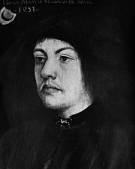Martin Schongauer (1440-1491)
Martin Schongauer (1440-1491)
 German engraver and painter. He was the most important German printmaker before Albrecht Dürer. His prints were circulated widely and Schongauer was known in Italy by the names Bel Martino and Martino d'Anversa. Schongauer was born in about 1440 in Colmar, Alsace as the sonsof Caspar Schongauer, a goldsmith from Augsburg who taught his son the art of engraving. He may well have been trained by Master E. S..
German engraver and painter. He was the most important German printmaker before Albrecht Dürer. His prints were circulated widely and Schongauer was known in Italy by the names Bel Martino and Martino d'Anversa. Schongauer was born in about 1440 in Colmar, Alsace as the sonsof Caspar Schongauer, a goldsmith from Augsburg who taught his son the art of engraving. He may well have been trained by Master E. S..All the works with Schongauer's M†S monogram show a fully developed style. Schongauer established at Colmar a very important school of engraving, out of which grew the "Little Masters" of the succeeding generation, and a large group of Nuremberg artists.
As a painter, Schongauer was a follower of the Flemish artist Rogier van der Weyden, and his rare existing pictures closely resemble, both in splendour of color and exquisite minuteness of execution, the best works of his contemporaries in Flanders. Only a few of his paintings survive,
As a painter, Schongauer was a follower of the Flemish artist Rogier van der Weyden, and his rare existing pictures closely resemble, both in splendour of color and exquisite minuteness of execution, the best works of his contemporaries in Flanders. Only a few of his paintings survive,
The main work of Schongauer's life was the production of a large number of beautiful engravings, which were largely sold, not only in Germany, but also in Italy and even in England and Spain. Vasari says that Michelangelo copied one of his engravings, in the Trial of Saint Anthony. His style shows no trace of Italian influence, but a very clear and organised Gothic.
His subjects are mainly religious, but include comic scenes of ordinary life such as the Peasant family going to market or the Two apprentices fighting. One hundred and sixteen engravings are generally recognised as by his hand, and since several are only known from a single impression, there were probably others that are now lost.
Among the most renowned of Schongauer's engravings are the series of the Passion and the Death and Coronation of the Virgin, and the series of the Wise and Foolish Virgins. All are remarkable for their miniature-like treatment, their brilliant touch, and their chromatic force. Some, such as the Death of the Virgin and the Adoration of the Magi are richly-filled compositions of many figures, treated with much largeness of style in spite of their minute scale.
He established the system of depicting volume by means of cross-hatching (lines in two directions) which was further developed by Dürer, and was the first engraver to curve parallel lines, probably by rotating the plate against a steady burin.
There are no products matching the selection.






 Facebook
Facebook Twitter
Twitter Subscribe us
Subscribe us Flickr
Flickr




